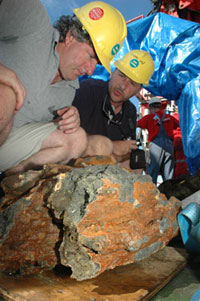List of Underwater Mining Institutes: 1970 to 2008
(updated Thursday 02 July 2009)

- 38th UMI 2008. Oxford, Mississippi. Marine Minerals: Technological Solutions and Environmental Challenges, November 17-22, 2008.
- 37th UMI 2007. Tokyo, Japan. Marine Minerals of the Pacific: Science, Economics, and the Environment, October 15-20, 2007.
- 36th UMI 2006. Kiel, Germany (Leibniz Institute of Marine Sciences at Kiel University). Scientific, Legal and Economic Perspectives of Marine Mining, September 24-30.
- 35th UMI 2005. Monterey, California US (US Geological Survey, Menlo Park, CA). Marine Minerals: Crossroads of Science, Engineering and the Environment, involving hydrothermal sulfide deposits, methane hydrates, engineering, manganese deposits, November 1-5.
- 34th UMI 2004. London, United Kingdom (Imperial College). Marine Minerals: The European Dimension covering recent development in aggregates and shelf minerals, hydrothermal mineralization, and recent engineering applications, September 1-7.
- 33rd UMI 2003. Jeju, Korea (Korea Ocean Research and Development Institute). New Horizons for Marine Mining: Progress through International Cooperation, October 6-10.
- 32nd UMI 2002. Wellington, New Zealand (Institute of Geological and Nuclear Sciences). New Perspectives on Seabed Mineral Deposits, involving submarine hydrothermal deposits with emphasis on volcanic arcs, seabed methane hydrates and hydrocarbon seeps, recent legal and regulatory issues, and new scientific discoveries.
- 31st UMI 2001. Hilo, Island of Hawaii (U.S. Geological Survey, Menlo Park, CA). Going to Extremes: Seabed Mining and Biotechnology, involving seabed hydrothermal deposits and their associated ecosystems.
- 30th UMI: 2000. Honolulu, Oahu, Hawaii (University of Hawaii) involving the commercial, technological, scientific, and political aspects of marine minerals development.
- 29th UMI: 1998. Toronto, Canada (University of Toronto) involving diamonds and metals: recent contributions of commercial activities and marine research to the development of high value terrestrial and marine deposits.
- 28th UMI: 1997. Seattle, Washington (Sound Ocean Systems, Redmond, Washington) involving the advancement of marine mineral studies and technological developments.
- 27th UMI: 1996. Washington, DC (National Academy of Sciences) involving marine minerals and international marine policy, and the development of nonliving resources.
- 26th UMI: 1995. St. John’s, Newfoundland, Canada (University of St. John’s at Newfoundland) involving aggregates and placers and environmental and policy issues.
- 25th UMI: 1994. Monterey, California (U.S. Geological Survey, Menlo Park, CA) involving environmental impacts of marine minerals development and the status of deep seabed mining and seabed hydrothermal deposits.
- 24th UMI: 1993. Estes Park, Colorado (University of Toronto and NOAA National Geophysical Data Center, Boulder, CO) involving massive sulfides in the oceans: lessons for land and sea exploration, November 7-10.
- 23rd UMI: 1992. Arlington, Virginia (U.S. Minerals Management Service, Herndon, VA) involving new discoveries of sulfide deposits, environmental impact studies, and continental shelf deposits, September 27-29.
- 22nd UMI: 1991. Kahuku, Oahu, Hawaii (Marine Minerals Technology Center, Hawaii and Mississippi) involving cobalt rich seamounts, sampling systems, sand mining, and geothermal development.
- 21st UMI: 1990. Victoria, British Columbia, Canada, involving environmental impact issues, September 23-26.
- 20th UMI: 1989. Madison, Wisconsin (Sea Grant Institute, University of Wisconsin-Madison), involving the latest information on hydrothermal studies, manganese nodules and crusts, placers, and marine mining technology, institutions, and financing, October 1-4.
- 19th UMI: 1988 Woods Hole, Massachusetts (U.S. Geological Survey, Woods Hole, MA; IMMS, MMTC (Hawaii and Mississippi) and Woods Hole Oceanographic Institution), October 2-5.
- 18th UMI: 1987. Newport, Oregon (NOAA Pacific Marine Environmental Laboratory), focusing on hydrothermal deposits and environmental impact issues, October 4-7.
- 17th UMI: 1986. Biloxi, Mississippi (Mississippi Minerals Resources Institute), focusing on marine aggregate mining, November 2-5.
- 16th UMI: 1985. Halifax, Nova Scotia, Canada (Sea Grant Institute, University of Wisconsin, IMMS, and University of Texas-Austin), focusing on hydrothermal deposits and Canadian marine research, October 20-22.
- 15th UMI: 1984. Madison, Wisconsin (Sea Grant Institute, University of Wisconsin-Madison), focusing on hydrothermal deposits.
- 14th UMI: 1983 Madison, Wisconsin (Sea Grant Institute, University of Wisconsin-Madison), focusing on September 1983 coring results on the Juan de Fuca Ridge and the latest on the Red Sea, November 6-8.
- 13th UMI: 1982. Madison, Wisconsin (Sea Grant Advisory Services, University of Wisconsin), focusing on new looks at traditional topics (placers, nodules, engineering constraints in coastal mining, and robotics) and on new papers on sulfides and spreading centers), October 26-28.
- 12th UMI: 1981. Madison Wisconsin (Sea Grant Advisory Services, University of Wisconsin), focusing on sulfides and the geopolitics and critical importance of our strategic mineral supply position, October 20-22.
- 11th UMI: 1980. Savannah, Georgia (Sea Grant Institute, University of Wisconsin), focusing on deep sea sulfides and in-shore placers, November 11-13.
- 9th UMI: 1978. San Diego, CA (Sea Grant Programs of U of Alaska and Wisconsin), focusing primarily on nodule mining, October 19-20.
- 8th UMI: 1977. Seattle, Washington (Sea Grant Programs of U of Alaska and Wisconsin), focusing on the changing events in the world scene of legal, political, and economic factors and the technological developments and environmental concerns., November 10-11.
- 7th UMI: 1976. Madison, Wisconsin (Sea Grant College Program, University of Wisconsin), focusing on manganese nodule mining, October 28-29.
- 6th UMI: 1975. Madison, Wisconsin (Sea Grant College Program, University of Wisconsin), focusing on manganese nodule and placer mining, October 2-3.
- 5th UMI: 1974. Milwaukee, Wisconsin (Sea Grant College Program, University of Wisconsin), focusing on manganese nodule mining, May 9-10.
- 4th UMI: 1973. Milwaukee, Wisconsin (Sea Grant College Program, University of Wisconsin), involving early commercial production of deepsea nodules, details of some new underwater mineral prospects, and some profitable approaches to both exploration and metal processing, April 12-14.
- 3rd UMI: 1972. Milwaukee, Wisconsin (Sea Grant College Program University of Wisconsin), involving early commercial production from new discoveries, including presentations on new underwater mines, April 27-28.
- 1st UMI: 1970. Milwaukee, Wisconsin (Sea Grant Program, The University of Wisconsin), focusing on manganese nodule mining, April 28-29.
[ Top of this page ]



